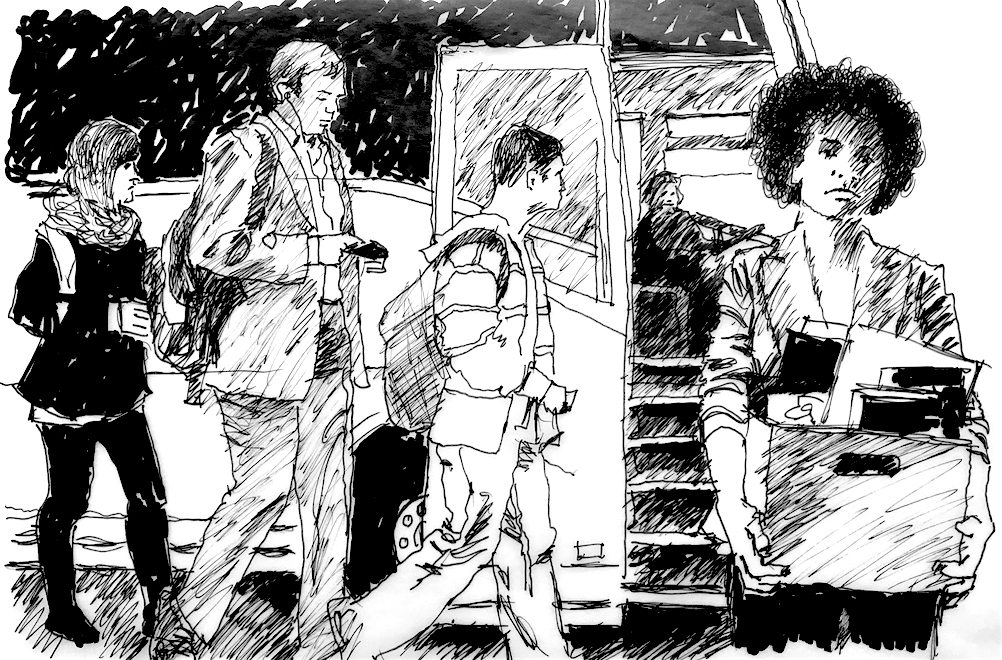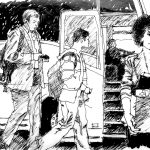Negotiating your way through disruptive change

Marketing, advertising, design and public relations employment are going through dramatic, wrenching changes. Yet we are creatives, after all; we can reach down deep – when forced to – and become what we need to be to thrive.
Walking down the hall, checking the numbers of the small conference rooms. E-223. E-223. Jane hadn’t spent much time in E building in her five years with the company. Now that she thought about it, she’d never been in E building.
“Where’s E-223?” Jane asked a passerby.
“It’s just on the other side. Go down that next hall on the left.”
It was early. She hadn’t had time to drop stuff at her desk yet. She’d jumped off the bus at the E stop and just run up the stairs to the second floor.
Jane didn’t want to be late meeting her boss’s boss. She’d only met with him a couple times – both about starting a project for him that involved something he was doing with the C-suite. But they’d met in the creative group’s conference room then.
E-223 turned out to be a small internal conference room. Jane knocked once. No response. The lights went on when she opened the door. “Good,” she thought. “I beat him. Not by much, though.”
“Jane, thanks for meeting me first thing,” he said as he entered. Bob had always struck Jane as a kind man. A man who pretty much had things going his way. But at the moment – red face, breathing hard – now that she reflected on it, he looked stressed.
“Of course. No problem. Always good to see you, Bob.”
Settling into the chair across from me, he pulled a file out of his pack. “Jane, I’m really sorry about this, but the company is letting you go.”
She thought she’d heard wrong. “What?” What’d he say? “Are you laying me off? Aren’t we doing well? I mean, isn’t the company doing fine?”
“It’s not that, Jane. As you know, there is a reorg underway, and the Mumbai team…”
Jane didn’t remember a thing he said after that. She was too busy fighting back tears, thinking, “I can’t cry.”
Turmoil
Outsourced teams, to cut costs. Digital everything; it’s fast and cheap. Design consultancies letting people go. National brands struggle while store brands grow. Malls shuttered as online sales grow. Advertising agency employment up, but boutique agencies struggle. Amateur smartphone photography displaces traditional photogs. In-house creative groups grow. Management consultancies buy product-design firms. Holding companies shed brand-design firms. Social media elects presidents. Forty percent of the U.S. workforce is freelance. Cat videos gain billions of views. Hate crimes grow.
While the turmoil of the greatest change since the Industrial Revolution rages, more people are engaged in providing creative services today than at any time in history. And more money is paid for top talent than ever. So there’s no loss of opportunity.
But not everybody wins. Some are left out.
Fired
“God, I’m fired. I’ve never been fired,” Jane thought as she carried her box out of the creative group area she’d worked in for five years.
People just arriving at work. They knew. Bob or somebody must have sent out a text. They were so sorry, but really didn’t want to talk about it. That was clear from how they looked away.
The mortgage? The car payment? What now? She was OK for a few months. These thoughts as she made her way back to the corporate bus stop. The company had been generous with severance. But in six months she’d be down to the little she’d been able to save. A wave of tiredness hit as she settled into the empty company bus for the return, and she slept most of the way home.
When she got off at the stop near her condo, the driver asked for her badge. “How’d he know?” she thought. Then her chest, held in a knot of denial, couldn’t hold on any longer. The sobs came hard. Cheeks wet, she stumbled down the steps to the curb, where a line of eager employees waited to board.
“Jane, Jane, are you all right?” A work acquaintance took her arm and looked into her wet eyes.
“I’ve just been fired.” That was a mistake.
The acquaintance let go of her arm and, rapidly distancing, mumbled, “I’m so sorry. I’m really sorry. Let’s connect over coffee. Got to go now.”
It started raining. Jane walked home.
Low point
Six months passed. No jobs in sight. Endless coffee dates, LinkedIn searches, referrals, connections – all with good, well-intentioned people. People who wanted to help.
Severance gone, in spite of her best efforts to conserve. Sell the car? That’s a possibility. Sell the condo? It was worth more than she paid. Not yet. Take out a second mortgage? Maybe.
But what about work? She’d been applying for as many opportunities as she could find. Done a fair number of interviews, and had a couple of what seemed like promising follow-up interviews. But no job offers.
On one interview she’d been told that her work looked like the past. She’d had many humiliating, painful moments. But that one was the worst.
She was tired of it all. She was lonely. Now she realized that her friends had all been connected to her job. Afternoons were the worst. Sometimes she couldn’t get off the couch or out of her pajamas all day. All she had felt was solid, permanent and real was now gone.
Passing the homeless on walks to the grocery, she imagined sleeping in the park.
Turning point
Jane had been a competitive runner in high school, and she got back into running two or three times a week – a positive – but she was running alone. It didn’t help with the loneliness, but it did get her creative juices flowing in the afternoons.
She’d taken a couple classes to improve her user-experience skills, and was working with a coach to help with interviewing and representing herself through writing. Then, during a conversation with her coach, it hit her: She needed to be part of a writers group. A group in which she could connect with other professionals, share ideas and improve her writing.
As her coach had pointed out several times, Jane was a natural storyteller. She’d probably been telling stories since she was little. In fact, Jane remembered deeply loving the made-up stories her mother would tell when she tucked Jane in for the night.
Jane had helped a couple small clients create WordPress sites in the months since she’d lost her job. But it had never occurred to her that she might go freelance as both a site designer and a writer. Her past jobs had all been with giant corporations, and her responsibilities had all been parts of large intranet sites.
With insights from her coach and one of her UX instructors, Jane connected with an informal group of writers who got together twice a month to compare notes, critique and support each other. Jane was nervous about measuring up. These were all professional writers, after all.
But in the first few minutes she realized the group was all about help, and she felt almost physically folded into their fabric of thoughtful inclusion. Once the group realized Jane could design and create websites as well as write, she picked up a couple design jobs.
That group was the turning point. Through the following six months Jane had enough work to cover the basics. In a year she was making a living. Not at the level of her corporate job, but enough.
Jane followed a proven creative process
Jane’s reactions and process were absolutely normal. With her feeling of security gone, the pain from her loss dominated. She felt shammed by being fired and embarrassed at the loss of her social net. Real fear was next, with the loss of income and the loss of the position that had seemed solid and permanent. Her job was now gone, and with it the security she’d accepted without question.
Her first instinct was to find a job. She hoped to replicate her old position. So she networked, interviewed and got training.
When Jane didn’t find another corporate position, she took control and did so with a bigger vision of what was possible. Her thoughts and her search widened beyond her corporate past. And that’s how she found a group that broadened her interests and provided supportive social connections.
Jane stepped beyond the confines of a job search; she reached back to her childhood, and she combined her adult skills and experiences with past interests. By doing this, she created a new future that more fully expressed who she really was and wanted to become.
The very technology that’s driving the disruptive change we’re all living in is what made Jane’s new vocation possible. It’s also the same wave of disruption that got her fired in the first place. That irony shows the duality of today’s creative world: you can fear falling victim to technology’s darker impacts, or you can use its revolutionary capabilities to create and navigate your own path.


